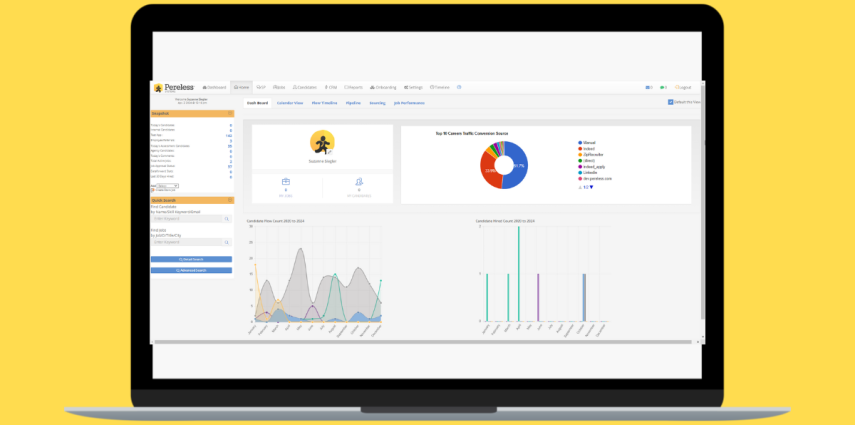As 2025 unfolds, the stakes for efficient recruitment have never been higher. Enter Applicant Tracking Systems (ATS)—the game-changers adopted by companies to slash time-to-hire and transform chaos into streamlined success. We’ve handpicked the 16 best ATS tools for 2025, curated across company sizes, strategic priorities, and budgets (in no particular strict ranking order). Whether you’re a lean startup dodging spreadsheets or an enterprise eyeing AI-powered scaling, find your edge here and gear up to hire smarter.
| # | ATS | Best for / Stand‑out feature |
| 1 | Pereless Systems | For enterprise organizations that want cost-effective recruitment tools have streamlined talent acquisition from sourcing to hiring. Experience seamless recruiting, all in one place. |
| 2 | Greenhouse | Mid‑to‑large organizations that want strong hiring analytics, structured interviewing and collaboration. Zapier+1 |
| 3 | Workable | Scaling companies that want a solid all‑rounder with good support, job board posting and candidate sourcing. Ongig Blog+2Zapier+2 |
| 4 | Lever | Companies who emphasize candidate engagement/passive sourcing and want CRM‑style recruiting. Zapier+1 |
| 5 | iCIMS | Enterprise‑level organizations seeking robust compliance, global scale and lots of integrations. Ongig Blog+1 |
| 6 | SmartRecruiters | End‑to‑end hiring platforms (ATS + other talent acquisition features) for global/complex hiring. How To Buy SaaS+1 |
| 7 | Zoho Recruit | Budget‑friendly and flexible, good for smaller teams or who already use the Zoho ecosystem. Built‑in AI features. Zapier+1 |
| 8 | Breezy HR | Smaller companies/startups looking for easy setup + good UI + price. Free or low‑cost entry. How To Buy SaaS+1 |
| 9 | JazzHR | Growing small‑/mid‑sized businesses who want a strong ATS without enterprise cost/complexity. How To Buy SaaS |
| 10 | Manatal | Budget conscious or smaller teams, including staffing/recruiting agencies; lots of features for less spend. Kula+1 |
| 11 | Pinpoint | Organizations that want custom workflows, high candidate experience, strong in‑house talent teams. Zimyo HRMS+1 |
| 12 | Ashby | Fast‑growing/hyper‑growth companies needing data‑driven hiring and advanced analytics. Kula+1 |
| 13 | RecruitCRM | Staffing and recruiting agencies needing ATS + CRM, large pipelines, candidate outreach. Talent Hero Media+1 |
| 14 | Bullhorn ATS | Large staffing firms, agencies – lots of volume and multiple job‑boards, complex recruiting pipelines. Whatfix+1 |
| 15 | Recruitee | Collaborative hiring, good for mid‑sized teams that emphasize team hiring and decent UX. Kula+1 |
| 16 | BambooHR (Hiring module) | Companies that want ATS plus HRIS / onboarding in one: good fit if you want more than just the ATS. Whatfix+1 |
Key Features to Compare:
When you go through demos or vendor conversations, compare:
- Candidate experience: How easy is it for applicants to apply? Mobile‑friendly? Does it feel smooth?
- Pipeline & workflow customization: Can you tailor stages, move candidates easily, integrate tasks/interviews?
- Automation & AI: Resume parsing, auto‑screening, interview scheduling, candidate communications. Zapier+2Zimyo HRMS+2
- Job board integrations & career page: Posting to multiple boards, branded career site.
- Reporting, analytics & data: What insights do you get (time‑to‑hire, source of hire, diversity metrics)?
- Integration with HRIS, onboarding & other systems: If you already have e.g., payroll/HCM, how well will ATS hook in?
- Scalability & cost model: Pay‑per‑user vs flat, how many jobs/hirings per year, support & implementation.
- Candidate‑centric features: Feedback loops, status updates, communications — helps brand/reputation.
- Compliance & security: Especially important for global companies or regulated industries.
- Ease of setup & use: Time to value, UI, training needed, support.
- Agency vs internal hiring: Some ATS are built for staffing firms vs for in‑house corporate HR.
How to pick your best fit:
Here’s a short decision flow to help you:
- Define your hiring volume / team size / projected growth for next 12–24 months.
- List your “must‑have” features (e.g., mobile apply, interview scheduling, diversity metrics, sourcing integrations).
- Map out your tech stack: Does the ATS need to integrate with HRIS, payroll, background screening, assessment tools?
- Set your budget (initial + ongoing). Check vendor pricing models.
- Shortlist 2‑3 ATS from above list (or beyond) that match your “size + use case”.
- Run demos with your real workflows, test candidate experience (apply themselves), ask for references.
- Consider change management: how you’ll onboard your hiring managers & recruiters, how much customization is needed.
- Plan for data migration (from spreadsheets or legacy system) if applicable.
- Negotiate implementation/support terms.
- Measure success: after launch track metrics like time‑to‑fill, candidate satisfaction, hiring manager satisfaction, pipeline bottlenecks.
Bradford’s Key Takeaway:
An ATS is not just “fancy job posting software”. It’s a strategic hiring tool. Picking the right one now means you’ll save time, hire better, scale easier, and maintain a strong candidate experience.












